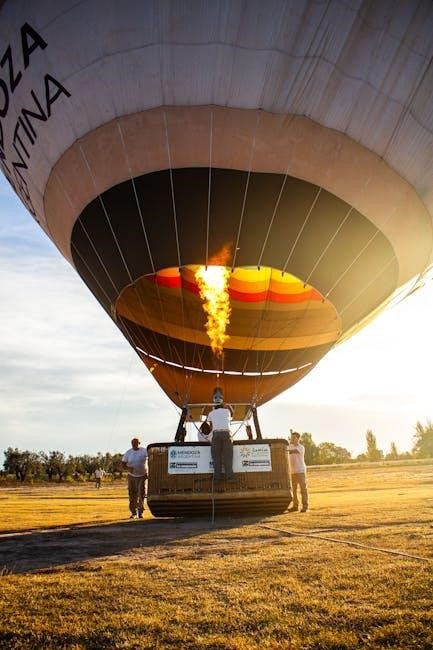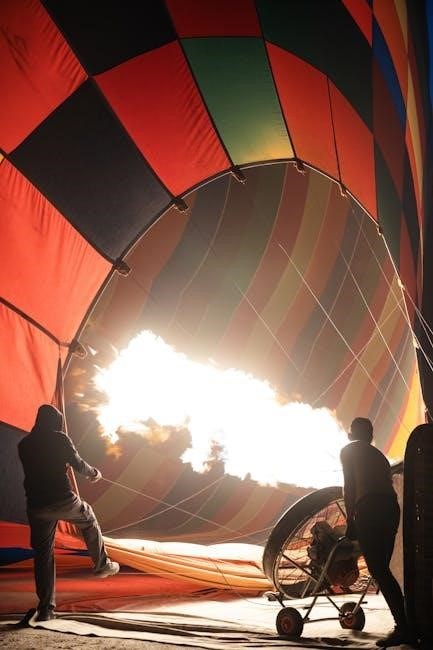Learn how to safely light and maintain your Heat & Glo pilot light with step-by-step guides, troubleshooting tips, and essential safety precautions for optimal performance and efficiency.
Understanding the Importance of the Pilot Light
The pilot light is a critical component of your Heat & Glo fireplace, ensuring safe and efficient operation. It acts as a continuous ignition source, igniting the main burner when needed. A properly functioning pilot light prevents gas leaks and ensures safe combustion. Regular maintenance and proper lighting techniques are essential to avoid hazards. Understanding its role helps homeowners operate their fireplace safely and effectively, ensuring reliable performance during colder months. Always follow manufacturer guidelines to maintain optimal function and safety.

Safety Precautions Before Lighting the Pilot Light
Always ensure proper ventilation, avoid smoking, and keep flammable materials away. If you smell gas, wait 5 minutes before attempting to light the pilot. Follow all safety guidelines to prevent accidents.
Essential Safety Measures to Follow
Ensure proper ventilation before lighting the pilot light. Turn off the gas supply if you smell gas. Keep flammable materials away and avoid smoking. Never light the pilot near open flames or sparks. If the pilot doesn’t light after several attempts, wait 5 minutes before retrying. Always refer to your specific Heat & Glo model’s manual for detailed safety instructions. Follow all manufacturer guidelines to prevent accidents and ensure safe operation of your fireplace.
Step-by-Step Instructions for Lighting the Pilot Light
- Open the gas supply valve and locate the pilot assembly behind the logs.
- Press and hold the pilot button, then press the igniter until the pilot lights.
- Hold the button for 30 seconds, then release slowly to ensure the flame stays lit.
Accessing the Pilot Assembly
To access the pilot assembly on your Heat & Glo fireplace, first ensure the gas supply is turned off. Remove the glass panels or front bezel to expose the firebox. Locate the pilot assembly, typically found behind the logs or at the back of the firebox. For some models, you may need to remove additional components like decorative screens or grates. Once accessible, inspect the pilot orifice and surrounding area for any debris or obstructions. Always refer to your specific model’s manual for precise instructions, as assembly locations may vary slightly between Heat & Glo models.
Operating the Gas Supply Valve and Igniter
Locate the gas supply valve, typically near the fireplace’s base or behind the control panel. Turn the valve to the “Pilot” position. Press and hold the valve knob, then press the red piezo igniter button repeatedly until the pilot flame appears. Hold the knob for 30 seconds to ensure the pilot stays lit. If using a manual model, use a long match or lighter to ignite the pilot while holding the valve. Always follow the manufacturer’s instructions for your specific Heat & Glo model to ensure safe and proper operation of the ignition system.
Troubleshooting Common Pilot Light Issues
Identify issues like the pilot not staying lit, no spark, or a weak flame. Check for blockages, ensure proper gas flow, and clean the pilot assembly if necessary.
Why the Pilot Light Won’t Stay Lit
The pilot light may fail to stay lit due to a dirty or clogged pilot assembly, improper gas flow, or a faulty thermocouple. Clean the pilot orifice with a small brush or compressed air. Ensure the gas supply valve is fully open and functioning correctly. If issues persist, inspect the thermocouple for damage or misalignment. Consult your Heat & Glo manual for specific guidance, as some models may require professional servicing. Always prioritize safety and proper ventilation when troubleshooting.
Diagnosing No Spark or Flame
If the pilot light doesn’t spark or produce a flame, check the igniter for proper function. Ensure the gas supply valve is fully open and unobstructed. Inspect the pilot assembly for dust or debris, cleaning it gently if needed. Verify that the spark igniter is producing sparks and aimed correctly at the pilot orifice. If no spark appears, the igniter or wiring may be faulty. Consult your Heat & Glo manual for model-specific troubleshooting steps or contact a certified technician for assistance. Always prioritize safety during diagnosis.

Maintenance Tips for the Pilot Light System
Regularly clean the pilot assembly, ensure proper ventilation, and inspect for obstructions to maintain optimal performance. Refer to your Heat & Glo manual for detailed care instructions.
Cleaning the Pilot Assembly
Regular cleaning of the pilot assembly is crucial for reliable operation. Turn off the gas supply and allow the assembly to cool. Use a soft-bristle brush or small vacuum to gently remove soot and debris. Avoid harsh chemicals or abrasive materials that could damage components. Inspect the pilot orifice for blockages and clean it with compressed air if necessary. Proper maintenance ensures a steady flame and prevents ignition issues. Always refer to your Heat & Glo manual for specific cleaning instructions tailored to your model.
Ensuring Proper Ventilation
Proper ventilation is essential for safe and efficient operation of your Heat & Glo system. Always ensure vents are clear of obstructions like debris or nests. Check that venting systems are securely connected and functioning correctly. Install a carbon monoxide detector to monitor air quality. Regularly inspect vent pipes for damage or wear. Ensure your fireplace is installed in a well-ventilated area to prevent gas buildup. Refer to your Heat & Glo manual for specific ventilation requirements and consider professional inspection for optimal safety and performance.

Model-Specific Instructions
Consult your Heat & Glo manual for model-specific pilot light instructions, as procedures vary across models like SL-550TR-IPI-E. Some feature Intellifire technology, while others require manual access. Always follow the manual for safe operation.
Variations in Heat & Glo Models
Different Heat & Glo models may have unique pilot light systems. For example, the SL-550TR-IPI-E features an Intellifire ignition system, eliminating the need for manual lighting. Other models, like the 6000TRSI, use a battery reserve for continuous pilot operation. Some models require accessing the pilot assembly behind glass panels or facades, while others have controls located elsewhere. Always refer to your specific model’s manual for precise instructions, as variations in design affect the lighting and maintenance process. Proper model-specific guidance ensures safe and efficient operation. Follow manufacturer guidelines closely for optimal results.
Advanced Features and Technologies
Heat & Glo features advanced technologies like electronic ignition and smart controls, enhancing safety and efficiency. These innovations simplify pilot light management and offer remote access, ensuring a seamless and convenient experience.
Intellifire Ignition System
The Intellifire Ignition System is a state-of-the-art electronic ignition technology designed to eliminate the need for manual pilot lighting. This system automates the ignition process, enhancing safety and convenience. It ensures consistent and reliable burner ignition, reducing the risk of gas leaks or improper lighting. With Intellifire, users can enjoy a hands-free experience, as the system automatically lights the pilot when needed, providing peace of mind and efficient operation.

Additional Resources and Support
Visit the Heat & Glo Owner Support Center for manuals, FAQs, and customer service. Access model-specific guides, troubleshooting tips, and technical support for optimal pilot light operation.
Heat & Glo Owner Support Center
The Heat & Glo Owner Support Center provides comprehensive resources for pilot light troubleshooting, maintenance, and operation. Access owner manuals, FAQs, and technical support for specific models. Register your product, find troubleshooting guides, and learn about advanced features like the Intellifire system. The support center also offers warranty information and repair assistance. Visit the official website or contact customer service for personalized help. This resource ensures you have everything needed to maintain and enjoy your Heat & Glo fireplace safely and efficiently.
Properly lighting and maintaining your Heat & Glo pilot light ensures safety, efficiency, and optimal performance. Always follow guidelines and consult resources for troubleshooting and support.
Final Checklist for Safe and Effective Pilot Light Operation
- Ensure the gas supply valve is fully open before lighting the pilot light.
- Remove glass panels to access the pilot assembly safely.
- Locate the pilot assembly, gas supply valve, and igniter button.
- Press and hold the valve knob in the pilot position while igniting.
- Hold the knob for 30 seconds after ignition to ensure a steady flame.
- Ensure proper ventilation to avoid gas buildup.
- Regularly clean the pilot assembly to maintain performance.
- Refer to the owner’s manual for model-specific instructions.
Final Note
Properly lighting and maintaining your Heat & Glo pilot light ensures safe and efficient operation. Always follow the manufacturer’s instructions and safety guidelines to avoid potential hazards. Regular maintenance, such as cleaning the pilot assembly and ensuring proper ventilation, will extend the lifespan of your system. For model-specific instructions, refer to your owner’s manual or consult the Heat & Glo Owner Support Center. By following these steps, you’ll enjoy a cozy, warm, and secure fireplace experience throughout the year.



